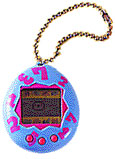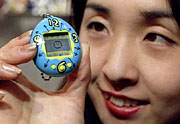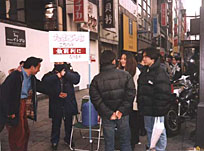This article has been reproduced from the March 1997 issue of Neo-Tokyo on-line magazine. It has been done to provide a permanent place for it, as they remove old materials from their magazine and replace them with new items. The magazine can be found at Neo-Tokyo Magazine. Their publication of the article was a little more "trendy" and included links to the authors and other references. The reference links have been moved to our Links Page.
Tamagocchi:
"AND THEY CALL IT PUPPY LOVE..."
By Xavier Bensky and Usman Haque
She has her own regular spot on a radio talk show, she has already come
out with two hit singles and now she has a music video in which she
dances and shows off her supermodel physique. In coming months, she is
scheduled to make live television appearances and star in soap operas.
 Who are we talking about? Meet Date Kyoko, Japan's first "virtual idol"
explicitly manufactured to be adored. Actually, she began as DK-96, Hori
Production's first creation in the "Digital Kids" project. She is not
based on any real individual, but was rather created polygon-by-polygon
from an image supposedly based on the idol in demand today.
Who are we talking about? Meet Date Kyoko, Japan's first "virtual idol"
explicitly manufactured to be adored. Actually, she began as DK-96, Hori
Production's first creation in the "Digital Kids" project. She is not
based on any real individual, but was rather created polygon-by-polygon
from an image supposedly based on the idol in demand today.
Young men all over Japan are falling in love with Date Kyoko. They write
to her, they download her video clips from the internet, and some even
plaster their PCs with her pictures. Her web pages have interviews with
her (she's remarkably erudite), horoscopes and now one can even find her
on the cover of magazines.
She's not the only one; if you prefer Enka singers ("country" ballad
music), click your way over to Yuki Usui, who has her own novel posted
on the internet. These "virtual-idols", manufactured predominantly for
ecstatic consumption by men, are cropping up everywhere; virtual love is
big business in a culture which has become more and more dependent in
recent times on instant gratification.
And yet, the irony is that these idols provide the precise counter-point
to gratification as normally understood: the love and devotion offered
by these youths is *always* unrequited. Photos of the idols, though
alluring, are barely erotic in anything other than a teasing way.
The pleasure of adoring a virtual Venus does not lie simply in explicit
titillation.
If there is any gratification at all (and there must be, since the
phenomenon is so popular) it lies precisely in the unattainability of
the loved one. Unreciprocated love is often the most passionate and it
could be argued that the ardour of infatuation is simply making up for a
loss somewhere else. The situation is somewhat different from the
pin-ups and pop-stars of latter days, where there was still the remotest
chance that the beloved might respond by falling in love too; in the
case of the virtual idol, the impossibility of a relationship is assured
and there is no fear of rejection because it is already clearly written
out from the start that no coupling will ever ensue. Lover continues to
love, beloved continues to ignore: a comfortable agreement.
Enter tamagocchi (tah-mah-goh-chee).
 Tamagocchi is a pet unlike any you've seen before; it's housed in an
egg-sized casing and needs nurturing throughout its short lifetime.
Wildly popular among high school students and rapidly winning the hearts
of office workers and business people, these 'adorable' pets are almost
always sold out and are in such demand that a black market has emerged
(at up to twenty times list price). They have spurred the creation of a
myriad mailing lists, websites and discussion groups. They've even
crossed the oceans, having recently been featured in CNN, the Washington
Post and Daily Telegraph. By May 1997, they will be available in Europe
and North America as well.
Tamagocchi is a pet unlike any you've seen before; it's housed in an
egg-sized casing and needs nurturing throughout its short lifetime.
Wildly popular among high school students and rapidly winning the hearts
of office workers and business people, these 'adorable' pets are almost
always sold out and are in such demand that a black market has emerged
(at up to twenty times list price). They have spurred the creation of a
myriad mailing lists, websites and discussion groups. They've even
crossed the oceans, having recently been featured in CNN, the Washington
Post and Daily Telegraph. By May 1997, they will be available in Europe
and North America as well.
Why so much attention?
These cute pets, just like Date Kyoko and Usui Yuki, are *virtual* and
live in the land of bits and bytes.
By acquiring a physicality (they may be carried in one's pocket or, as
is popular now with high-school girls, dangled from one's neck) and by
requiring human interaction, Bandai Corp.'s tamagocchi have overturned
the "virtuality" of virtual love and have challenged conventional
notions of producer and consumer in mass culture.
The consumer has now become active in the development of the adored
object. The pets need to be fed, cleaned, played with, scolded (when
necessary) and vaccinated(!). This is done by pressing small
buttons below the LCD screen through which the tamagocchi is depicted.
The critters are raised from birth and experience childhood, adolescence
and adulthood within the space of one week; alas, they usually expire
within ten days.
In this respect, they are ideally suited to the busy lives of
contemporary Japanese, who lack the space but urgently need the
emotional outlet. In a country where owning a pet is a luxury many
cannot afford, either in terms of time or money, tamagocchi is available
for the mere price of a movie ticket (under 2,000 yen). Of course, for
single office workers who can't care for a cat or a dog at home,
tamagocchi is the perfect solution.

However, unlike virtual idols, tamagocchi strikes at the very heart of
the unrequited love paradigm: instead of romanticism or passion, they
take the option of a more mature, selfless, almost maternal love. No
longer a relationship of titillation, these pets are appealing to a much
broader audience among both men and women. Caring for tamagocchi, like
any pet, requires a platonic devotion which, in its altruism, reaffirms
one's own importance; just as religious devotion elsewhere has often
emphasised love through selflessness, so does tamagocchi free itself
from a love of masochism, jealousy or obsession.
Indeed, tamagocchi have acquired a spiritual domain: a virtual temple
now exists on the internet. When your pet dies, you can go to the
"temple", give offerings, and leave prayers in a funerary bulletin
board. Within the tamagocchi mailing list, bereaved owners reminisce
about their dearly departed pets. "Sorry for not cleaning up after you
enough", mourns one high school student. An office worker sighs: "You
were so much fun. If only I hadn't turned the sound off I would have
heard your cries of hunger."
Tamagocchi is not simply a toy: the act of "going to temple" legitimises
the relationship and distinguishes it from a mere plaything. Date Kyoko
and other idols involved a one-way relationship: one's narcissistic
fantasies were projected recursively upon the idol. Interestingly,
stalking has been on the increase in Japan... Tamagocchi, on the other
hand, reinforces one's own identity by engaging the owner into a
dialogue with an Other. Identity is reaffirmed because the relationship
emphasises the distinctness, as well as the co-dependency, of owner and
pet. As the French philosopher Emmanuel Levinas has said: "I am
concerned with the other; inasmuch as he is a stranger, he is my
brother". Thus, there is a shift from simple 'projections of desire' to
a more sophisticated 'acceptance of otherness'.

This is a crucial shift in the context of Japanese society. It has long
been argued that young Japanese people today are suffering from a
so-called "identity crisis" which springs from the ongoing conflict
between traditional values as espoused in dominant political and social
narratives and the influx of other influences. The crisis consists of
young people dealing with their own cultural hybridity, in which their
identity is put into question. In this respect, caring for tamagocchi is
fundamentally an identity-affirming action.
Version 2 (Tamagotch Shinshu Hakken - "New Species Discovered") was
released on February 1st. At the time of this writing, no-one (but
Bandai Corp., presumably) knows what the first generation will look
like.
One thing *is* sure: this phenomenon is bound to have a significant
impact on Japanese society, even if only because office workers will be
spending so much more time away from their desks, hiding in the
bathrooms to care for their darling Tamagocchi.
Xavier Bensky: Graduate student at McGill University writing Master's on
Japanese stand-up comedy, research in Japanese cultural studies and media. Living in Montreal.
Usman Haque: Architect, etc. living (for the moment) in New York City.
Copyright © 1997 Xavier Bensky, Usman Haque and Neo-Tokyo Magazine. All rights reserved.
This document is for your own personal use. Please do not distribute it or repost without express written permission from the Editor.
 Who are we talking about? Meet Date Kyoko, Japan's first "virtual idol"
explicitly manufactured to be adored. Actually, she began as DK-96, Hori
Production's first creation in the "Digital Kids" project. She is not
based on any real individual, but was rather created polygon-by-polygon
from an image supposedly based on the idol in demand today.
Who are we talking about? Meet Date Kyoko, Japan's first "virtual idol"
explicitly manufactured to be adored. Actually, she began as DK-96, Hori
Production's first creation in the "Digital Kids" project. She is not
based on any real individual, but was rather created polygon-by-polygon
from an image supposedly based on the idol in demand today.
 Tamagocchi is a pet unlike any you've seen before; it's housed in an
egg-sized casing and needs nurturing throughout its short lifetime.
Wildly popular among high school students and rapidly winning the hearts
of office workers and business people, these 'adorable' pets are almost
always sold out and are in such demand that a black market has emerged
(at up to twenty times list price). They have spurred the creation of a
myriad mailing lists, websites and discussion groups. They've even
crossed the oceans, having recently been featured in CNN, the Washington
Post and Daily Telegraph. By May 1997, they will be available in Europe
and North America as well.
Tamagocchi is a pet unlike any you've seen before; it's housed in an
egg-sized casing and needs nurturing throughout its short lifetime.
Wildly popular among high school students and rapidly winning the hearts
of office workers and business people, these 'adorable' pets are almost
always sold out and are in such demand that a black market has emerged
(at up to twenty times list price). They have spurred the creation of a
myriad mailing lists, websites and discussion groups. They've even
crossed the oceans, having recently been featured in CNN, the Washington
Post and Daily Telegraph. By May 1997, they will be available in Europe
and North America as well.


